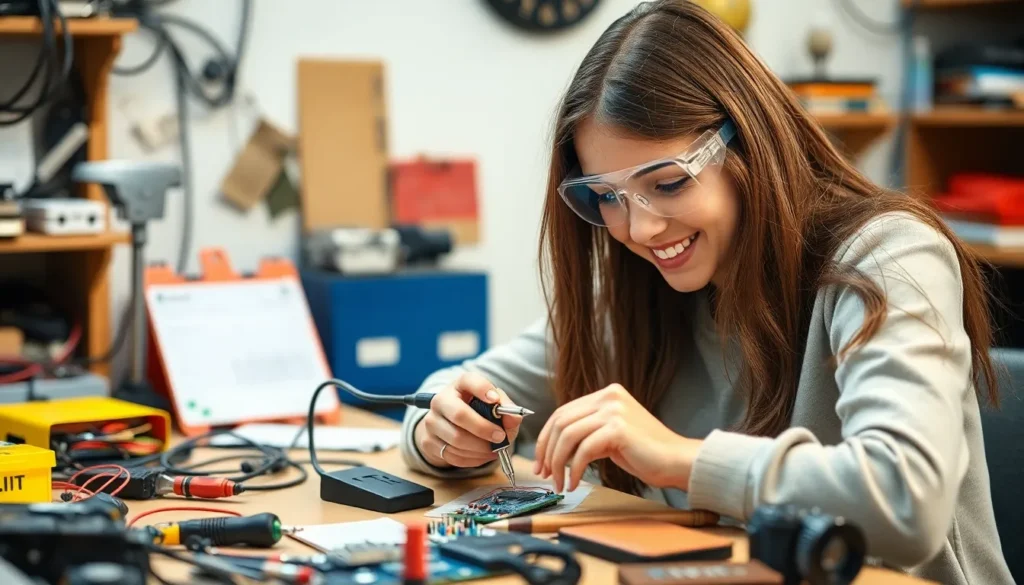Engineering isn’t just for the lab coat-wearing geniuses anymore. With DIY engineering projects, anyone can unleash their inner inventor and create something truly amazing. Whether it’s building a robot that can fetch snacks or designing a solar-powered gadget, these projects offer a fun way to blend creativity with technical skills.
DIY Engineering Projects
DIY engineering projects engage individuals of all skill levels and interests in hands-on activities. Many people explore concepts such as electronics, mechanics, and sustainability without the constraints of formal education. For instance, building robots and designing solar-powered devices present accessible ways to learn about technology.
Projects often vary greatly in complexity, allowing participants to select options that match their skills. Beginners might start with simple electronics kits, while advanced individuals can experiment with programming and robotics. Many resources are available online, including tutorials and forums that foster learning and collaboration.
Community plays a crucial role in DIY engineering. Makerspaces and workshops provide environments where enthusiasts can share ideas and materials. Participants can connect with peers, gain support, and access tools that may not be available at home. Engaging in these projects promotes creativity and problem-solving skills.
Safety remains a priority in DIY engineering. Proper handling of tools and materials is essential to prevent accidents. It’s advisable to follow guidelines when conducting experiments, especially when dealing with electricity or chemicals.
Cost varies based on the nature of the projects. Materials can range from inexpensive household items to specialized components. Budget-conscious experts recommend starting with online resources to identify affordable options.
Overall, DIY engineering projects encourage innovation and foster a practical understanding of engineering principles. They invite individuals to explore new technologies while imparting essential skills that are increasingly relevant in today’s world.
Benefits of DIY Engineering Projects

DIY engineering projects offer numerous advantages that enhance both personal skills and financial savings.
Skill Development
Engaging in DIY engineering projects enables individuals to develop practical skills in problem-solving and critical thinking. Participants strengthen their understanding of concepts like electronics, mechanics, and design by applying learned theories in real-world settings. Exploring various tools deepens proficiency with hands-on applications. Individuals experience growth in creativity as they brainstorm innovative solutions to engineering challenges. Curiosity drives them to learn new techniques and technologies, which enhances their overall capabilities. Online resources such as tutorials and forums provide valuable support, making it easier for anyone to begin learning. Each project can serve as a stepping stone, nurturing confidence for future endeavors.
Cost-Effectiveness
DIY engineering projects often prove to be budget-friendly alternatives to commercial products. Participants can find many affordable materials through local suppliers and online marketplaces, allowing them to manage expenses effectively. Many projects use recycled or repurposed items, contributing to sustainability while saving money. By experimenting and creating designs, individuals avoid high labor and product costs associated with hiring professionals. This cost-effectiveness enhances accessibility for people of all ages. Sharing resources within communities or makerspaces encourages collective budgeting, ensuring everyone can participate. Overall, engaging in DIY projects promotes financial prudence without compromising the enjoyment of engineering exploration.
Popular DIY Engineering Projects
DIY engineering projects provide endless opportunities for creativity and learning. Several popular project categories engage different interests and skill levels.
Home Automation
Home automation projects simplify everyday tasks. Smart lighting systems can connect to smartphones for remote control. Integrating voice assistants allows easy operation of appliances and devices. A temperature control system can enhance energy efficiency, leading to cost savings. Resources online offer detailed guides for setup. Tools like Arduino and Raspberry Pi provide a solid foundation for various automation projects. Embarking on these projects often sparks a deeper interest in computer programming and electronics.
Renewable Energy Solutions
Renewable energy projects focus on sustainability. Building a solar panel system can significantly reduce energy costs. Wind turbines serve as an alternative, especially in suitable locations. DIY enthusiasts often experiment with different designs to maximize efficiency. Knowledge about energy consumption builds awareness of environmental impact. Local workshops frequently share insights on available materials and techniques. Experimenting with renewable energy enhances understanding of engineering principles and promotes ecological responsibility.
Robotics
Robotics projects fascinate a wide audience. Individuals can create simple robots using kits or build from scratch with available components. Programming these machines to complete tasks develops coding skills. Projects could range from automated vehicles to robotic arms designed for specific tasks. Collaboration within makerspaces often leads to innovative developments. Competitions encourage participants to test their designs and improve problem-solving abilities. Exploring robotics enhances knowledge while fostering creativity and teamwork.
Tools and Materials Needed
Engaging in DIY engineering projects requires specific tools and materials. These essentials aid in creating innovative solutions and exploring engineering principles effectively.
Essential Tools
Basic tools facilitate various DIY projects. A multimeter allows for testing electrical components and measuring voltage, current, and resistance. Wire cutters and strippers help in manipulating wires for electronic circuits. A soldering iron is crucial for joining components securely. Precision screwdrivers enable careful assembly of intricate parts. Additionally, pliers assist in gripping and bending materials as needed. Finally, a utility knife provides versatility for cutting various materials.
Recommended Materials
Choosing the right materials enhances project outcomes. Commonly used items include jumper wires for connecting circuits easily, as well as breadboards for prototyping without soldering. Sensors and actuators control various devices, making them significant in robotics projects. Cardboard and wood serve as structural components for many builds. Resistors and capacitors are essential for managing electrical flow in circuits. Additionally, recycled materials, such as plastic bottles and old electronics, promote sustainability while inspiring creativity.
Tips for Successful DIY Engineering
Identify specific project goals before beginning any DIY engineering endeavor. Goals help in planning and selecting appropriate materials and tools. Researching similar projects provides insights into best practices and challenges. Utilize online resources and communities for guidance and troubleshooting.
Gather tools and materials in advance. Common tools include multimeters, wire cutters, and soldering irons. Essential materials consist of jumper wires, breadboards, and sensors. Ensure safety equipment, such as goggles and gloves, is also accessible.
Plan each step meticulously. Sketching designs or creating flowcharts aids in visualizing the project. Breaking tasks into smaller, manageable segments simplifies the process. Documenting progress can help in troubleshooting later stages.
Test components individually for functionality before final assembly. Testing ensures each part operates correctly, reducing frustration during the project. Also, utilizing prototypes can facilitate adjustments and improvements.
Engage with community resources such as makerspaces or workshops. Collaboration fosters knowledge sharing and provides access to expert advice. Networking with experienced DIY engineers enhances skills and expands creative possibilities.
Be mindful of budgets. Source materials from local suppliers or consider recycled options to minimize costs. Planning expenditures carefully supports multiple projects without overspending.
Finally, embrace experimentation. Mistakes can lead to innovation and deeper understanding of engineering principles. Permitting flexibility in design processes cultivates creativity and encourages unique solutions.
Conclusion
DIY engineering projects open a world of possibilities for creativity and learning. They empower individuals to explore engineering concepts while developing essential skills. With diverse project categories available, there’s something for everyone, whether it’s home automation, renewable energy, or robotics.
The accessibility of tools and materials makes it easier than ever to start a project. Engaging with community resources enhances the experience and fosters collaboration. By embracing experimentation and learning from mistakes, individuals can innovate and deepen their understanding of engineering principles.
Ultimately, DIY engineering projects not only inspire curiosity but also promote ecological responsibility and practical problem-solving skills. It’s time to dive into the exciting world of DIY engineering and unleash creativity.



